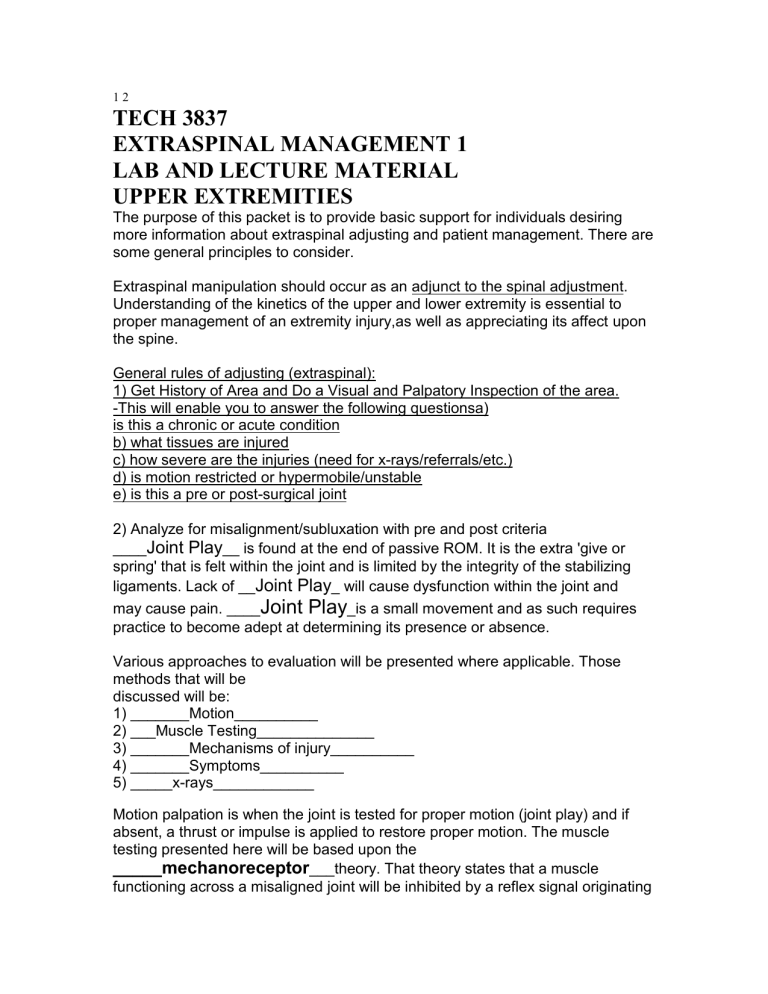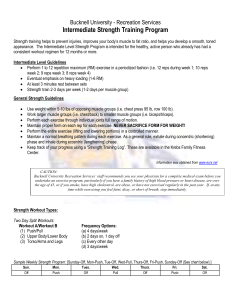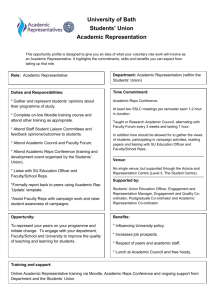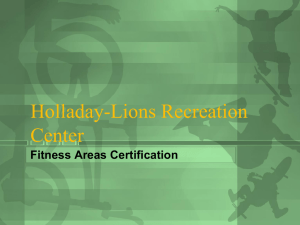File - LU Class of Winter 2013

1 2
TECH 3837
EXTRASPINAL MANAGEMENT 1
LAB AND LECTURE MATERIAL
UPPER EXTREMITIES
The purpose of this packet is to provide basic support for individuals desiring more information about extraspinal adjusting and patient management. There are some general principles to consider.
Extraspinal manipulation should occur as an adjunct to the spinal adjustment.
Understanding of the kinetics of the upper and lower extremity is essential to proper management of an extremity injury,as well as appreciating its affect upon the spine.
General rules of adjusting (extraspinal):
1) Get History of Area and Do a Visual and Palpatory Inspection of the area.
-This will enable you to answer the following questionsa) is this a chronic or acute condition b) what tissues are injured c) how severe are the injuries (need for x-rays/referrals/etc.) d) is motion restricted or hypermobile/unstable e) is this a pre or post-surgical joint
2) Analyze for misalignment/subluxation with pre and post criteria
____
Joint Play
__ is found at the end of passive ROM. It is the extra 'give or spring' that is felt within the joint and is limited by the integrity of the stabilizing ligaments. Lack of __
Joint Play
_ will cause dysfunction within the joint and may cause pain. ____
Joint Play
_is a small movement and as such requires practice to become adept at determining its presence or absence.
Various approaches to evaluation will be presented where applicable. Those methods that will be discussed will be:
1) _______Motion__________
2) ___Muscle Testing______________
3) _______Mechanisms of injury__________
4) _______Symptoms__________
5) _____x-rays____________
Motion palpation is when the joint is tested for proper motion (joint play) and if absent, a thrust or impulse is applied to restore proper motion. The muscle testing presented here will be based upon the
_____mechanoreceptor
___theory. That theory states that a muscle functioning across a misaligned joint will be inhibited by a reflex signal originating
from mechanoreceptors surrounding that joint. The adjustive line of correction may be the same using the various methods of evaluation and most of these methods may also be used as a 'post- check' of the joint.
Adjusting the extraspinal area may be accomplished by:
1) __________Hands Only__________________
2) _____________Instruments_______________
3) ______________Mechanically Assisted (Drop)__________________
The concept of extraspinal management within the Chiropractic paradigm must include integration of the extraspinal area to the spine. This may take place in a number of ways. First one must consider the_________
neuorological
_____connection, (i.e. nerve root levels of innervation) then the_____
musculature__________,
which crosses the area and if the muscles, are prime movers or stabilizers. One may assess the dominant motion of the joint as well as the dominant, motion in the activities of daily living.
CASE MANAGEMENT
TEMPLATE
History
Is the ___
Extremity
__________ mentioned in the chief complaint?
Is it primary or secondary to the main complaint?
Was there direct trauma or gradual onset?
Is it acute or chronic?
When are the symptoms worse or better?
What has the patient done to try to correct the problem?
Activities of daily living?
Hobbies?
Sleeping pattern?
Do you take pain medication? When and how much?
Upper extremity
What portion of the kinetic chain is primary?
Which portion will magnify the forces entering or exiting?
Is swelling present?
When? i.e. upon rising in the morning or at the end of the day?
With physical activity or with rest?
What position is the rest of the body in during activities?
Is the forearm pronated or supinated?
Is paresthesia present? When? Where?
General health
If both upper and lower extremities are noted in chief complaint:
Are they on the same side or opposite?
Is the
____Pain
_________ level the same in both?
At the same time?
Are certain _____ Positions _____or _______
Movements
____ worse than others?
What is the relative _______
Position
___________ of all parts of the body?
Do both areas have a history of direct trauma?
BASED UPON YOUR TECHNIQUE LOGIC - EXAMINE EITHER THE AREA OF
COMPLAINT OR
THE SPINE
If muscle testing is used, it is best to test strength first whether adjusting the spine or not. Evaluate the spine and adjust if indicated, _
Recheck
_______the strength and adjust the extremity if________
Weakness
__________ is still present.
*******If only a mechanical alignment problem is present, it may be addressed at any convenient time within the adjusting process, e.g. talus.
WHEN EXAMINING AN EXTRASPINAL AREATHINK –
ACUTE OR CHRONIC?
WHAT TISSUES ARE INJURED?
TO WHAT DEGREE ARE THE TISSUES INJURED?
IS THERE RESTRICTION OF MOTION OR INSTABILITY?
IS THIS PRE OR POST SURGICAL AREA?
COULD THIS BE A CAUSE OR EFFECT?
IS THERE A SPECIFIC ACTIVITY THE PATIENT SHOULD AVOID?
IS REST, SUPPORT, OR BRACING INDICATED?
ARE THERE HABITS THAT WILL EXACERBATE THE AREA?
IS REHABILITATION NEEDED?
WHAT TYPE OF EXERCISES WILL THE PATIENT ACCEPT?
REMEMBER YOUR GOALS MUST BE SIMILAR TO YOUR PATIENT
OR OUTCOME ASSESSMENT WILL FAIL
EXTRASPINAL MANAGEMENT LOGIC
VENUE vs. OFFICE
ACUTE vs. NON-ACUTE
MECHANISM OF INJURY
BENEFIT vs. RISK
STABILITY&
ANATOMICAL INTEGRITY
ADJUSTMENT vs. MANIPULATION
SOFT TISSUE
CONFIDENCE vs. COMPETENCE
The incorporation of extraspinal areas into adjusting into your practice should be based upon some criteria. Listed below are several viewpoints on such criteria.
1) Trauma
If acute, check for patient
_______patient Safety
___, then joint
_______stability
_____, then________
subluxation
_______.
These are known as the
___________3 S’s
__________.
If chronic, check for residual joint
____Instability
________, then
____
subluxation______.
Often acute injuries to the extraspinal areas are forgotten as soon as the pain is gone, but the result of these injuries is usually altered joint mechanics in the form of fixations and/or hypernobility. If left uncorrected, these altered joint mechanics may produce chronic asymptomatic stressors to the extremity, as well the spine.
2) Dysfunction
If one understands the potential for the extraspinal areas to produce irritation or stressors to the spine, then checking for muscle weakness, motion, or altered biomechanics, is appropriate.
THE BODY WILL INNATELY _____
Compensate
_____________ FOR
INJURY. THE MORE SUBTLE THE PROBLEM THE LONGER THE
__________
Compensation
___________ WILL BE PRESENT PRIOR TO
OUTWARD EXPRESSION. THE MORE TRAUMATIC THE INJURY THE
QUICKER THE BODY WILL BE FORCED TO COMPENSATE AND THE
QUICKER THE PATIENT IS
____
Compensation
____________EXPRESSIVE.
Reasons or causes:
1) Abnormal stress upon a normal structure.
2) Normal stress upon an abnormal structure.
3) Normal stress upon a normal structure that is not, at that time prepared to receive the stress.
Picking up Luggage
Examples:
Work up:
Five questions you must answer prior to adjusting (extraspinal)
1) Is this a chronic or acute disorder?
2) What tissues are damaged?
3) The severity of the damage.
4) Is there instability or restriction of motion?
5) Is this a pre or post surgical area?
Strain v. Sprain:
LIGAMENT (sprain) MUSCLE/TENDON(strain)
GRADE 1 7-10 days - no residual laxity no residual weakness
GRADE 2 Plastic deformation, residual laxity muscle tear (partial)
GRADE 3 Complete rupture of structure complete tear
The most common injuries seen in the office are __ Grade 1 or Mild Grade II ___.
Grade 3 injuries will heal without reconstruction, but they will almost never return to normal stability and or function.
Remember serious grade two and grade three legally requires a
____________ medical referral ________________.
Mechanism of injury:
1) _________ Joint Position_ __________________ (open to closed packed)
2) ______________ Forces Involved ______________
3) ______________ Time of Episdoe ______________ (quickly or over a long period of time)
The mechanism of injury (MOI) will often lead to a better understanding of the tissues injured and the potential concerns. Except in the case of direct trauma, the spine is always considered first.
Close packed position:
The end of travel in a joint whereby the surfaces are at maximum congruency, the ligaments are taut, and further movement in that direction of travel may result in ___________ Dislocation/ Fracture ______________.
Loose or Open packed position:
The positions of travel of a joint away from the close packed position where by the capsule and ligaments are not taut. Extreme movement in that direction usually results in _______ Sprain/ Strain ________________.
Degenerative changes:
Loss of normal _____________ Joint Mechanics _______________ leads to degenerative changes, which produces ________ Inflammation _____ and lead to __________ Fibrotic ________ response, which then promote -altered joint mechanics.
Trauma:
Hyperemia / inflammation:
Passive congestion:
Consolidation or protein exudate:
Re-organization via fibroblastic activity / secretion of collagen:
Healing by 1st intent (similar tissue) or 2nd intent (connective tissue/fibrosis)
_
Fibrosis:
Ischemia:
Weaker repair:
Less elastic:
Hypersensitive:
Exacerbations:
Altered functional capacity:
Further fibrosis,
trophy,
chronic pain and
disability
Initial Healing: 3 - 10 days
Regeneration: 6 - 8 weeks
Remodeling: 6 months - 2 years +
Rehabilitation:
1) What was the pre-injury status of the patient?
2) What are the specific goals of the patient and doctor?
3) What rehabilitation equipment or facilities are available?
4) What is the likelihood of patient compliance?
Joint play:
Joint play is the accessory motion in a joint that is detectable by passive stress to the joint and is essential to proper joint function
Hydrodynamics:
Essential for proper lubrication, transport of nutrients, and removal of waste material from the articular surfaces. Proper hydrodynamics occur during:
1) _____________ Weight Bearing _______________________
2) ________________ Intermittent Muscle Activity ____________________
3) ______ Full Range of Motion of the joint and its capsule _________________
Radiographic Considerations:
Radiographic studies may be conducted at anytime the Doctor chooses. From the medical model -reasons for x-ray may include: trauma(damage or unusual palpalable findings, history ( familial or personal), age (over the age of
40~pathology or history of problems), muscle strength loss ( if not 50% improved
in two weeks after adjusting or care), and always in the case of litigation (CYA and objective initial findings).
SHOULDER
Four articulations :
S/C (sternoclavicular),
A/C (acromioclavicular),
G/H (glenohumeral),
ST (scapulothoracic).
Stability is sacrificed for motion - correct proprioception is essential for proper position of the humeral head in the glenoid cavity. Purpose of the shoulder is to move the arm in order to place the hand where we needs it to be. The size ratio between the humeral head and the glenoid cavity has been compared to a golf ball and its tee. Over time scapulas tend to migrate ___ Superior ___ and
_______ lateral________, making a shallow glenoid cavity more shallow - leading to more shoulder complaints. Patient’s shoulder rehab and exercise advice should include, strategies for slowing down and or reversing this scapular migration.
S/C - only osseous articulation with the axial skeleton, critical for stability of the upper extremity, typically dislodged by ______lateral ____________ to
______ medial _____ forces (acute trauma or cumulative, such as sleeping on the same side). This joint is likely the most responsible for the majority of the
_______ Proprioceptive _______ information for the upper extremity.
A/C - less __________ mobile __________ than the S/C usually however is the area of CC, often is _________ hypermobile _____________ due to restrictions/fixations at the S/C articulation.
G/H - most often affected by _________ rotator cuff dysfunction __ or the tendon of the long head of the biceps. Fix biceps tendon as if displaced
_________ lateral ________to the bicipital groove, this is believed to be the correct direction 90% of the time. Check function via
______biceps ____ muscle test strength.
S/T - non-synovial articulation, primarily scapular => subscapularis => bursae => serratus => ribs, all must be free to translate for proper upper extremity function.
__________ 2nd ____________ overlooked region of the shoulder next to the
S/C articulation.
9 2
ELBOW
Functionally a stable joint. Closed packed position is in full
_______ extension ___________.
________ Triceps ____________ muscle is a good indicator via mechanoreceptors.
Medial epicondylitis -golfers elbow = typically _____PM___________ ulna
Lateral epicondylitis -tennis elbow = typically ________PL_________________radius
Both misalignments _____PM______ ulna and ________ PL__________ radius may occur via hyperextension injury (falling, bracing against a steering wheel in an MVA.) This may be the underlying problem in pronator teres syndrome, which may mimic carpal tunnel syndrome. Patient is tested by pronation against resistance; symptoms follow a median nerve distribution.
Additional notes:
PUSH / PULL WORKOUT
Torso - Abs./ Low back - A
Perform daily as warm up in Superset fashion.
Reverse Crunch
Cross Crunch
Front Crunch
3 supersets/15-20 reps
Torso Twists
Hip Extensions
Hip Ab/adductors
Low Back Extensions *can use machines
Workout # 1 -Chest Shoulders and Triceps
Note: Always pyramid all weights on each exercise
BENCH PRESS (any variation) 3 sets/ 15/10/6-8 reps
INCLINE BENCH 3 sets/ 15/10/6-8 reps
PEC FLYS – HUG (any variation) 3 sets/ 15/12/10 reps
SHOULDER PRESS (any variation) 3 sets/ 15/10/8 reps
FRONT RAISES 3 sets/ 15/12/10 reps
LATERAL RAISES 3 sets/ 15/12/10 reps
TRICEP PUSHDOWNS 3 sets/ 12/10/8 reps
TRICEP EXTENSION 3 sets/ 12/10/8 reps
Workout #2 –Glutes, Thighs and Calves
LEG EXTENSION and 3 supersets to warm-up (15 to 20 reps)
LEG CURLS
LEG PRESS/SQUATS 3 sets/ 15/ 10/6-8 reps
LUNGES 3 sets/ 12/ 10/6-8 reps
STIFF LEG DEADLIFTS 3 sets/ 10/ 10/ 10 reps
TOE RAISES (any variation) 4 sets/ 12/12/10 reps
SEATED TOE RAISES 4 sets/ 12/12/10 reps
Workout #3 -Back, Rear Shoulders and Biceps
LAT PULLDOWNS (any variation) 3-sets 15/10/6-8 reps
LAT ROWS (any variation) 3 sets 15/10/6-8 reps
PULLOVERS 3 sets 15/12/10
REAR FLYS/RAISES 3 sets 12/12/10
UPRIGHT ROWS 3 sets 12/12/10
DUMBELL SHRUGS 3 sets 15/12/10
BARBELL CURLS 3 sets 12/10/8
DUMBELL CURLS 3 sets 12/10/8
Daily routine would include: Day 1 - A and Workout # 1
Day 2 - A and Workout # 2
Day 3 - A and Workout # 3
Day 4 - A and Aerobic exercise
(run/swim/bike)
Day 5 - A and Workout # 1
Day 6 - A and Workout # 2 etc.,etc.
12 2
WRIST AND HAND
Carpals are _________________________________________- moving not due to muscle contractions but the motion of surrounding structures, gliding diagonally and anterior with wrist extension or posterior with wrist flexion. If wrist pain is reduced or range of motion enhanced by applying mild pressure approximating distal ulna and radius - a ________________________ may have occurred via __________________________ or________________________ insult to the wrist. Distal forearm may also be manifesting symptoms due to elbow dysfunction.
Initial motion ____________________ occurs at the radiocarpal joint and secondary motion at the mid carpal and carpal metacarpal joint. Therefore, if there is a decrease of ROM or pain at full flexion, check for A to P restriction at the mid-carpal or carpal metacarpal joint. If there's pain at the beginning of flexion, check radiocarpal joint.
Initial motion ____________________ occurs at the carpal/carpal and metacarpal carpal joint and secondary motion occurs at the radiocarpal joint. Therefore, if there is a decrease of ROM or pain at full extension - check P to A restriction at the radiocarpal joint. If there's pain at the beginning of extension check the mid-carpal or carpal/carpal joints for restricted motion.
An ________________ muscle test is a good indicator of median nerve involvement. Weakness of this muscle with arm in ________________ usually indicates median nerve pressure at the wrist. Weakness with arm in
____________________-usually indicates median nerve irritation at the elbow
(pronator teres syndrome)- usually a PM ulna and a PL radius .
Support wrist in a decompressed position for best results.
Exercise with rubber bands on the fingertips (DIPs) with maximum phalangeal extension, this will aid in stabilizing the wrist. Exercise for 3-5 minutes, 3-times per day for 3 weeks then, recheck for stability.







